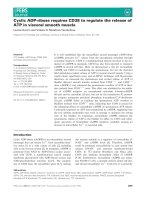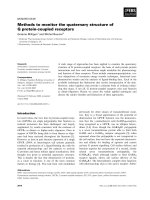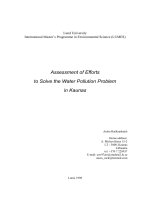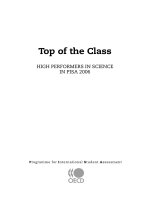Resampling methods to handle the class imbalance problems in predicting protein protein interaction site and beta turn
Bạn đang xem bản rút gọn của tài liệu. Xem và tải ngay bản đầy đủ của tài liệu tại đây (1.65 MB, 79 trang )
Resampling Methods to Handle
the Class-Imbalance Problems in Predicting
Protein-Protein Interaction Site and Beta-Turn
NGUYEN THI LAN ANH
July, 2013
Dissertation
Resampling Methods to Handle
the Class-Imbalance Problems in Predicting
Protein-Protein Interaction Site and Beta-Turn
Graduate School of
Natural Science & Technology
Kanazawa University
Major subject:
Division of Electrical Engineering
and Computer Science
Course:
Intelligent Systems
and Information Mathematics
School registration No.: 1023112109
Name: NGUYEN THI LAN ANH
Chief advisor: Professor KENJI SATOU
Abstract
Proteins are the active functional biomolecules. They are responsible for many tasks
in the cells, such as catalyzing the biochemical reactions, creating the cell walls,
involving in the defending the body from foreign invaders, involving in the movement,
and so on. Most proteins interact with the other proteins or molecules to perform their
functions; only a small number of them can work alone.
Though many advances have been achieved in the field of genome biology and
Bioinformatics, the functions of many protein sequences have not been determined
until now. However, the functions of the unknown protein can be inferred from the
functions of the known proteins that interact with it. In addition, functions of a protein
directly depend on its three-dimensional structure. The understanding of protein is the
understanding its sequence, structure and function. Therefore, studying of
protein-protein interaction and protein structure is very important in bioinformatics
and has been receiving a lot of interests.
The study of protein-protein interaction aims to localize where protein sequence
can physically interact, and to predict which proteins interact with which others. The
first problem is called protein-protein interaction sites prediction. Learning about this
issue leads to the understanding how proteins recognize the other molecules.
Predicting -turns and their types is one of the protein structure prediction
problems, and also is one of the interesting and hard problems in bioinformatics in
recent years. The purpose is to provide more information for fold recognition study.
However, the performances of both -turns prediction and protein-protein interaction
sites prediction are still far from being perfect. One of the main reasons is the
existence of class-imbalance problem in the datasets.
This thesis intends to enhance the performances of predicting (i) the
protein-protein interaction site by relaxing the class imbalance problem utilizing our
novel over-sampling method together with using predicted shape strings; and (ii) the
-turn and beta-turn’s types applying PSSMs, predicted protein blocks and random
under-sampling technique.
i
For the predicting protein-protein interaction sites problem, experimental results
on the dataset that contains 2,829 interface residues and 24,616 non-interface residues
showed a significant improvement of our method in comparison with the other
state-of-the-art methods according to six evaluation measures.
We performed experiments on three standard benchmark datasets that contain 426,
547 and 823 protein sequences, respectively, to evaluate the performance of our
method for predicting the -turns and their types. The results showed the substantial
improvement of our approach compared with the other strategies.
ii
Acknowledgments
This thesis marks the end of my three years of studying in Japan. From the depth of
my heart, I would like to take this opportunity to thank everyone, who has given me a
lot of kind help all the time I have been here.
I am deeply grateful to my supervisor, Professor Kenji Satou, for everything he
has given me from the first moment picking me up at the airport to date. I greatly
appreciate him for his enthusiasm, his patience, and for always giving the valuable
and insightful advices to me. I thank him for teaching me not only Bioinformatics but
also Japanese and the knowledge about the world.
I am thankful to Doctor Osamu Hirose for giving insightful comments and
suggestions. I would like to thank Professor Yoichi Yamada, Professor Mamoru Kubo
for their support.
My deep thanks go to all the committee members, Professor Kenji Satou,
Professor Haruhiko Kimura, Professor Tu Bao Ho, Associate Professor Yoichi
Yamada, and Lecturer Hidetaka Nambo for reading my thesis and giving the
constructive comments.
I am so proud and excited to be a part of Bioinformatics Laboratory, Kanazawa
University. I would like to show my greatest appreciation to everyone for the
collaboration. Especially thanks to Tho, Seathang, Vu Anh, Kien and Luu for the
wonderful moments we had together.
I would like to offer my special thanks to all of my Japanese teachers and the staff
of Kanazawa University for their enthusiasm; to my sincere Japanese friends for their
kindness. My life here was absolute hard without their help.
My gratitude goes to all the members of Vietkindai for supporting and helping me.
I owe my deepest gratitude to my colleagues in the Department of Informatics,
Hue University's College of Education, Hue University, especially to Mr. Nguyen Duc
Nhuan, for their support. I never can finish my study without their help.
To my teacher, Doctor Hoang Thi Lan Giao, I am so grateful for her guidance, her
care and her encouragement to me.
Thanks to my close friends for always being there for me.
iii
Thanks to my little Vietnamese students. They are one of the reasons makes me
keep trying.
Thanks to Freda. Though short, she made my days in Wakunami Shukusha be
meaningful with friendship.
Many thanks go to my neighbors in Hinoki Apaato, Minh, Nguyen, Tu and Manh,
who have treated me as a sister without any condition. Especially thanks for sharing
food with me and listening to my talk whenever I need.
It can be longer than my thesis if I list all the people who have helped me to have
today; but I always appreciate all.
And of course, my deepest appreciation goes to my Dad and Mom, my
grandfather, my brother and sisters, to my little nieces. I never can thank enough for
their sacrifice.
Thanks to beloved Vietnam for giving chances and welcome me back. Thanks to
beautiful Japan for great experiences.
The last three years are the important part of my life and will go with me to the
end; I will respect for both good and bad memories, and will keep in my heart forever.
Thank you so much!
iv
Contents
Abstract
............................................................................................................... i
Acknowledgments.........................................................................................................iii
Chapter 1
1.1
Introduction .......................................................................................... 1
Introduction ................................................................................................... 2
1.1.1
Protein overview ................................................................................ 2
1.1.2
Protein-protein interaction sites prediction........................................ 7
1.1.3
-turn prediction ................................................................................ 9
1.1.4
Class-imbalance problems ............................................................... 12
1.2
Objectives .................................................................................................... 14
1.3
Contributions ............................................................................................... 15
1.4
Thesis Organization ..................................................................................... 15
Chapter 2
Methods for Dealing with Class-imbalance Problems....................... 17
2.1
Standard Classifier Modeling Algorithm .................................................... 18
2.2
The State-of-the-art Solutions for Class-imbalance Problems .................... 19
2.2.1 Resampling techniques .................................................................... 19
2.2.2 Algorithm level methods for handling imbalance ........................... 22
2.3
Feature Selection for Imbalance Datasets ................................................... 23
2.4
Evaluation Metrics ...................................................................................... 26
Chapter 3
Improving the Prediction of Protein-Protein Interaction Sites Using a Novel
Over-sampling Approach and Predicted Shape Strings ....................................................... 28
3.1
Introduction ................................................................................................. 29
3.2
Materials and Methods ................................................................................ 30
3.2.1 Dataset ............................................................................................. 30
3.2.2 Methods ........................................................................................... 30
3.3
Results and Discussions .............................................................................. 35
3.3.1 Evaluation on the D1050 Dataset .................................................... 35
3.3.2 Evaluation on the D1239 Dataset .................................................... 39
3.4
Chapter 4
Conclusion ................................................................................................... 44
Improvement in -turns Prediction Using Predicted Protein Blocks
and Random Under-sampling Method ......................................................................... 45
v
4.1
Introduction ................................................................................................. 46
4.2
Materials and Methods ................................................................................ 46
4.2.1 Datasets ............................................................................................ 46
4.2.2 Feature vector .................................................................................. 47
4.2.3 Experimental design ........................................................................ 48
4.2.4 Filtering ........................................................................................... 49
4.2.5 Performance metrics ........................................................................ 50
4.3
Results and Discussions .............................................................................. 51
4.3.1 Turn/non-turn prediction ................................................................. 51
4.3.2 Turn types prediction ....................................................................... 55
4.4
Conclusions ................................................................................................. 58
Chapter 5
Conclusions ........................................................................................ 59
5.1
Dissertation Summary ................................................................................. 59
5.2
Future Works ............................................................................................... 60
Bibliography
............................................................................................................ 62
vi
List of Figures
Figure 1.1
Basic structure of amino acid. .................................................................. 2
Figure 1.2
The condensation of two amino acids to form a dipeptide. ...................... 3
Figure 1.3
Antibody Immunoglobulin G recognizes foreign particles that might be
harmful to defend the body. ......................................................................... 3
Figure 1.4
Four levels of protein structure. ................................................................ 4
Figure 1.5
Torsion angles and of the polypeptide backbone ............................... 5
Figure 1.6
The protein blocks. ................................................................................... 6
Figure 1.7
Illustration of protein-protein interaction interface residues of sequence
1FJG-F and ribosomal subunit S18. ......................................................... 8
Figure 1.8
A n example of beta-turn that contains four consecutive residues .......... 10
Figure 1.9
Illustrative stereo drawings of beta-turn types. ...................................... 12
Figure 1.10 An illustration of an imbalanced dataset. ............................................... 14
Figure 2.1
A n illustration of SMOTE algorithm. .................................................... 20
Figure 2.2
C luster-Based Sampling method example. ............................................ 21
Figure 2.3
F ilter method. Figure adapted from ..................................................... 24
Figure 2.4
Wrapper method. Figure adapted from .................................................. 26
Figure 3.1
Schematic representation of our method ................................................ 35
Figure 3.2
MCC vs. sensitivity of the two methods KSVM-only and OSD on the
D1050 dataset ......................................................................................... 37
Figure 3.3
R OC curves of the competing methods on the D1050 dataset ............... 39
Figure 3.4
M CC vs. sensitivity of KSVM-only and OSD on the D1239 dataset .... 40
Figure 3.5
R OC curves of the competing methods on the D1239 dataset ............... 41
Figure 3.6
PR curves for the datasets with shape string (D1239) and without shape
string (D1050) prediction with KSVM as basic classifier ...................... 42
Figure 4.1
The general scheme of our method......................................................... 50
Figure 4.2
ROC curves for the comparison of various feature groups, without
feature selection on the BT426, BT547 and BT823 datasets. ................ 52
Figure 4.3
R OC curves of KLR and our method on the BT426 dataset. ................. 53
Figure 4.4
R OC curves on BT547 and BT823 datasets. ......................................... 54
Figure 4.5
ROC curves of our method on the three datasets BT426, BT547, and
BT823. .................................................................................................... 57
vii
List of Tables
Table 1.1
Kinds of tight turns in protein ................................................................... 10
Table 1.2
Average values of dihedral angles of beta-turn types. .............................. 11
Table 2.1
A taxonomy of feature selection techniques ........................................... 25
Table 3.1
Performance measures comparison of different methods on the dataset
D1050 in terms of best G-mean ................................................................ 37
Table 3.2
Performance
of
KSVM-THR-only,
OSD-THR,
RUS-THR
and
RUS-OSD-THR with different decision threshold values on the dataset
D1050 ........................................................................................................ 38
Table 3.3
Performance
of
KSVM-THR-only,
OSD-THR,
RUS-THR
and
RUS-OSD-THR with different decision threshold values on the dataset
D1239 ........................................................................................................ 43
Table 3.4
Performance measures comparison of different methods on the dataset
D1239 ........................................................................................................ 44
Table 3.5
Performance measures comparison on the datasets D1239 and D1050 .... 44
Table 4.1
The type turn’s distributions (%) in the datasets ....................................... 47
Table 4.2
The evaluation results of using different window sizes for PSSM values
and predicted protein blocks without under-sampling and feature selection
on the BT426 dataset................................................................................. 51
Table 4.3
The evaluation results of the three datasets using different kinds of feature
groups with sliding window size of 9, without under-sampling and feature
selection .................................................................................................... 53
Table 4.4
Comparison of competitive methods on the BT426 dataset. .................... 54
Table 4.5
Comparison of competitive methods on the BT547 and BT823 datasets. 55
Table 4.6
Beta-turn types predicting results of our method on the BT426, BT547
and BT823 datasets ................................................................................... 56
Table 4.7
MCCs comparison between the competitive methods.. ............................ 56
viii
Chapter 1
Introduction
In this chapter, we introduce some basic concepts related to our methods in the
next chapters, such as protein structure levels, torsion angles, protein blocks, -turn,
and so on. After that, we briefly present some concepts and research problems of
protein-protein interaction sites and -turns and their types prediction. And then,
class-imbalance problem, one of the difficulties in predicting protein-protein
interaction site and -turn is introduced. Dealing with these problems is our purpose.
Finally, we show the contributions and organization of our thesis.
1
1.1 Introduction
1.1.1 Protein overview
Protein
Proteins are cellular large molecules that are constructed from chains of hundreds or
thousands amino acids. Each chain is called a polypeptide. Each individual amino
acid in this chain is called a residue. Two amino acids link together through the
peptide bond.
There are 20 amino acids that most commonly occur in nature. All of them consist
of the same part, but the side chain R, as in Figure 1.1
Figure 1.2 presents the way that two amino acids link together to form a dipeptide
in a protein chain.
Figure 1.1 Basic structure of amino acid.
The
different
amino
acids
have
the
different
side-chain
R.
(Figure
adapted
from
/>
Proteins play a very important role in the cells of living organisms. Each protein
has a specific function, for example, enzymes catalyze the metabolic reactions;
structural protein involves in creating the cell wall; regulatory proteins regulate the
transcription of genes; transport proteins bring molecules traveling through the body;
antibodies help to protect the body by binding to the specific foreign invaders such as
bacteria or viruses, and so on.
2
Most proteins interact with the other molecules to perform their function. If the
interactions between proteins in a cell disappear, the cell will be blind, deaf, paralytic
and disintegrate.
Figure 1.2 The condensation of two amino acids to form a dipeptide. (Figure adapted from
ttp://en.wikibooks.org/wiki/An_Introduction_to_Molecular_Biology/Function_and_structure_of_Protei
ns)
Figure 1.3 presents an example of antibody Immunoglobulin G traveling in the
blood and protecting the body by binding with the invaders.
Figure 1.3 Antibody Immunoglobulin G recognizes foreign particles that might be
harmful to defend the body.
(Figure downloaded from />3
Functions of proteins directly depend on their structure and shape. Protein
structure can be presented as four levels (Figure 1.4):
The primary structure is a linear amino acid sequence.
Secondary structure refers to the local spatial arrangement of a polypeptide’s
backbone atoms without regard to the conformations of its side chains.
Tertiary structure is the three-dimensional structure of an entire protein sequence.
Some proteins contain more than one polypeptide chain. In this case, quaternary
structure of a protein is the arrangement of the three-dimensional polypeptides.
b)
a)
c)
d)
Figure 1.4 Four levels of protein structure.
a) Primary structure is a sequence of amino acids.
b) Secondary structure is the spatial arrangement of the specific regions.
c) Tertiary structure is the 3D structure of the whole polypeptide chain.
d) Quaternary structure, if exists, is the 3D structure of many polypeptide chains.
4
Torsion angles
The backbone (main chain) of a protein includes the atoms which participate in the
peptide bonds. It can be displayed as a linked sequence of rigid planar peptide groups
and described by the torsion angles (dihedral angles) and . is the angle between
two adjacent planes (CNC) and (NCC); and is the angle between the planes
(NCC) and (CCN) (Figure 1.5). These two angles are defined as 180 if the
polypeptide sequence is fully extended conformation. Torsion angles are among the
most important local structural parameters that control protein folding. If we know the
values of these angles, we would be able to predict the corresponding protein 3D
structure.
Figure 1.5 Torsion angles and of the polypeptide backbone
Figure adapted from />
Protein blocks
Secondary structure of protein is very important for fold recognition. Secondary
structures have been classically described into three states of backbone conformation
as -helix, -sheet and coil. Around 50% of total number protein residues are
assigned as coils. Meanwhile, these residues actually correspond to many distinct
local protein structures. Therefore, a new view of three-dimensional protein structure
that combines the small local fragments (or prototypes) has been developed. A
structural alphabet (SA) is a complete set of these prototypes [1].
5
Because each residue relates to one of the fragments in a SA, a protein primary
structure can be translated into a chain of prototypes in one dimension as the sequence
of prototypes [2].
Many structural alphabets were developed, such as Building Blocks, Recurrent
local structural motifs, Substructures, Structural Building Blocks, Oligons, Protein
Blocks, LSP, Kappa-alpha, and so on. The more details can be found in [1].
Protein Blocks (PBs) [3] that allows a good approximation of local protein 3D
structures [4] and has been applied to many applications at the present time [2, 5].
This SA is composed of sixteen local structure prototypes of five consecutive C,
called Protein Blocks (PBs), labeled a, b, c, d, e, f, g, h, i, j, k, l, m, n, o, p,
respectively. Each of these prototypes represents a vector of eight average dihedral
angles /. Figure 1.6 displays these kinds of blocks.
Figure 1.6 The protein blocks.
For each protein block, the N-cap extremity is shown on the left and the C-cap on the right. Each
prototype is five residues in length and corresponds to eight dihedral angles (φ,ψ). The protein blocks
m and d are mainly associated to the central region of α-helix and the central region of β-strand,
respectively [2]
6
1.1.2 Protein-protein interaction sites prediction
Protein-protein interactions play a major role in maintaining normal cell functions and
physiology [6]. Specifically, they are responsible for many important biological
processes, such as metabolic control, DNA replication, protein synthesis,
immunological recognition, and so forth. Thus, studying of protein-protein interaction
is a vital task in bioinformatics. This realm contains two main goals, recognizing the
interaction sites (or protein interfaces) where proteins physically contact, and
predicting which pairs of proteins can interact. The knowledge of protein interfaces
allows us to understand the way protein recognizes the other molecules and engineers
new interactions. It is also very useful in identifying drug targets, designing drug-like
peptides to prevent unwanted interactions [7, 8]. The demonstration of the interaction
sites of two protein sequences is presented in Figure 1.7.
There are many experimental methods to identify the protein interaction sites and
interface residues, such as X-ray Crystallography, Nuclear magnetic resonance [9] or
Site-specific mutagenesis [10]. However, these approaches are expensive,
time-consuming and problematic for transient complexes [11], while computational
methods are more cost-effective.
Predicting protein-protein interaction sites by machine learning methods can be
dealt as a classification problem that to predict whether an amino acid is an interface
residue or not. The features that can distinguish interaction and non-interaction
residues are used to describe protein site [11].
There are two main groups of methods for predicting protein-protein interaction
sites, the methods using protein structure and the methods using protein sequence
information [12].
The protein structure based methods represent each residue by information of its
nearest neighbors in structure [13–15], thus they can utilize the informative features.
However, the number of known-structure proteins to date is significantly smaller than
the amount of protein sequences [16]. Therefore, it is necessary to develop the
methods that can predict the interface residues from the amino acid sequence only,
without knowing structural information. These methods generally generate the
features for each residue from information of it and its neighbors in the sequence.
Some studies have attempted to develop the techniques for predicting interaction
7
sites from protein sequences. For example, Kini and Evans [17] relied on the most
common appearance of proline in the flanking segments of interaction sites to propose
the prediction method; Chen and Li [18] combined the hydrophobic and evolutionary
information of amino acid to construct the prediction model; Chen and Jeong [16]
extracted a wide range of features from protein sequences only and using Random
Forests to create a prediction integrative model, and so forth.
However, it is not easy to apply sequence-based methods for interaction sites
prediction due to the lack of understanding of biological properties that can provide
vital information related to binding sites. Ofran and Rost [19, 20] proved that using
better information would induce better prediction results. On the other hand, because
the number of non-interacting residues is much more than the number of interacting
residues, it often leads to the high value of false predicted negative.
Figure 1.7 Illustration of protein-protein interaction interface residues of sequence
1FJG-F and ribosomal subunit S18.
Reds denote the interface residues.
(Figure adapted from />
8
1.1.3 -turn prediction
There is a tight relationship between a protein sequence, structure, and its function.
The understanding of structural basis for protein function can speed up the progress in
systems biology that aims at identifying functional networks of proteins. For example,
the rational drug design heavily relies on the structural knowledge of a protein [6].
Secondary structure, that includes regular and irregular patterns, is very important
in protein folding study since it can provide the useful information to derive the
possible three-dimensional structures. The regular structures, composed of sequences
of residues with repeating and values, classified in -helix and -strand. While
this class is well defined, the other class, irregular structures, involves 50% of
remaining protein residues are classified as coils. In fact, coil can be tight turn, bulge
or random coil. Among of these structures, tight turn is the most important from the
viewpoint of structure as well as function [21].
Tight turns are categorized into -turn, -turn, -turn, -turn and -turn basing on
the number of consecutive residues in the turn. Table 1.1 displays the kinds of tight
turns.
-turn is one of the most common tight turns. A -turn is composed of four
consecutive residues that are not in an -helix and the distance between the first and
the fourth C is less than 7Å [22] (Figure 1.8). -turns play an important role in the
conformation as well as the function of protein, and make up around 25% of the
residue numbers. -turns are the essential part of -hairpins, provide the directional
change of the polypeptide [23], and involve in the molecular recognition processes
[24]. In addition, the formation of -turn is a vital step in protein folding [25].
Therefore, the knowledge of -turn is very necessary in the prediction of
three-dimensional structure of a given primary protein sequence.
9
Figure 1.8 An example of beta-turn that contains four consecutive residues.
The C- are numbered from 1 to 4. Dot line represents hydrogen bond
Table 1.1 Kinds of tight turns in protein
Type
No. of residues
H-bonding
-turn
2
NH(i)-CO(i+1)
-turn
3
CO(i)-NH(i+2)
-turn
4
CO(i)-NH(i+3)
-turn
5
CO(i)-NH(i+4)
-turn
6
CO(i)-NH(i+5)
-turns are categorized into nine types (I, I’, II, II’, IV, VIa1, VIa2, VIb and VIII)
based on the dihedral angles of residues i+1 and i+2 in the turn [26]. The detailed
values of these angles corresponding to each type are shown in Table 1.2. Because the
turn types VIa1, VIa2 and VIb are rare, they are often combined into one type and
named VI [21]. Figure 1.9 below displays the illustrative drawings of nine -turn
types.
The -turn prediction methods can be divided into two main categories: statistical
techniques and machine learning techniques. The former group includes the
techniques such as Chou-Fasman’s method [27], Thornton’s methods [28, 29], Chou’s
method [30], the 1-4 and 2-3 correlation model [31] using the positional frequencies
and -turn residue conformation parameters; and the more recently method COUDES
10
[32], that used the propensities and multiple sequence alignments.
The latter group was reported to be effectively applied for -turns prediction in
recent years [33]. Belonging to this realm, Artificial Neural Network (ANN) was first
used in [34], then frequently used by the other authors [22, 35, 36]. Support Vector
Machines (SVMs) were also selected by many authors [24, 33, 37–41]. The most
recent reported result is KLR, which used kernel logistic regression for prediction,
with 0.5 on Matthews correlation coefficient (MCC) [42].
Most of the methods for the turn types prediction are based on ANN [35, 43, 44]
or probabilities with multiple sequence alignments as COUDES [32]. More recently,
Kountouris and Hirst [33] and X.Shi [45] used SVM in their methods and achieved
the significant results. However, the quality of both -turn location and turn types
prediction is a challenge.
Table 1.2 Average values of dihedral angles of beta-turn types.
The third residue of turns type VIa1,VIa2, VIb must be a proline [21, 26]
Type
I
I’
II
II’
IV
VIa1
VIa2
VIb
VIII
i+1
Dihedral angles ()
i+1
i+2
i+2
distance (Å)
-60
60
-60
60
-61
-60
-120
-135
-60
-30
30
120
-120
10
120
120
135
-30
0
0
0
0
17
0
0
160
120
4.6
4.6
4.6
4.6
7.2
3.4
3.7
6.0
6.3
-90
90
80
-80
-53
-90
-60
-175
-120
11
Figure 1.9 Illustrative stereo drawings of beta-turn types.
The distances between Cα(i)-Cα(i+3) in type IV are slightly greater than 7Å since this type is a
miscellaneous category and not really considered as an authentic -turn [21]
.
1.1.4 Class-imbalance problems
In recent years, class-imbalance problems have been receiving many deep
concerns because of their importance. A dataset is imbalanced if the number of
samples in some classes is significantly larger than in other classes. In the case of
two-class datasets, the class with small amount of samples is the minority (positive)
class while the other is the majority (negative) class. For multi-class imbalanced
datasets, there can be some minority classes, and in some situations, every class is the
minority. However, in this thesis, we just focus on the two-class problem to agree with
the common practices [46–50]. Figure 1.10 presents an illustration of imbalanced
dataset.The class-imbalance problem is often found in the real decision systems which
try to detect the rare but important cases such as fraud detection [51, 52], oil spills in
12
satellite images of the sea surface [53], risk management [54], text categorization [55]
and so on. In the field of bioinformatics, this problem is very common, such as
miRNA
prediction
[56],
beta-turns
prediction
[33,
42],
prediction
of
protein-interaction sites [16, 57, 58], protein-ATP binding residues prediction [59],
microRNAs classification [60–62], translation initiation site recognition [63], et cetera.
In some cases, the ratio of minority class to majority class can be as extreme as 1:100
or 1:100,000 [46]. When applying standard machine learning to the such datasets, it
often harvests a poor performance that results from the accuracy. Most of the learning
systems can be seriously influenced and tend to predict majority class exactly while
users desire for both high sensitivity and specificity. One of the most common
examples in real biomedical applications is the “Mammography Data Set,” the
collection of images acquired from a series of mammography exams performed on a
set of distinct patients. Analyzing the images in a binary sense, the natural classes are
labeled “Positive” for an image representative of a “healthy”, and “Negative” for a
“cancerous” patient. This data set contains 10,923 “Negative” samples and 260
“Positive” samples. We expect a classifier will provide 100% of predictive accuracy
for both the minority and majority classes on the dataset. However, the reality showed
that classifiers tend to provide a severe imbalanced degree of accuracy, with the
majority class having close to 100% accuracy and the minority class having
accuracies of 0-10 percent. If a classifier achieves 10% accuracy on the minority class
of the mammography data set, it means that 234 minority samples are misclassified as
majority samples. The consequence of this is equivalent to 234 cancerous patients
diagnosed as noncancerous. This is clearly an undesired result [46].
In addition, class distribution and error costs also affect the learning algorithms.
Standard classifiers assume that (i) the algorithms will perform on data drawn from
the same distribution as the training data while the training and testing distributions
are often different; (ii) the errors coming from different classes have the same costs
while they are unlike in practice [64].
To solve this problem, many strategies have been proposed. Basically, all of them
are divided into two categories: data level including the resampling methods, and
algorithmic level including the methods aiming at adjusting the parameters of
machine learning algorithms [46, 49]. However, [46] shows that resampling
techniques are more effective on improving classifier accuracy than algorithm level
13
methods. Due to that reason, in this study, we mainly focus on the resampling
techniques.
Figure 1.10 An illustration of an imbalanced dataset.
Blackened shapes represent samples; circles are majority class samples and stars are minority class
samples.
1.2 Objectives
Because of the importance of predicting the interface residue and -turn and what
kind of turn it is, our thesis aims to the following problems:
Firstly, we would like to improve the performance of predicting protein interface
residue by solving the problem of class-imbalance. To do that, we propose a new
over-sampling algorithm for balancing the dataset. We chose the dataset that contains
2,829 interacting residues and 24,616 non-interacting residues for training and testing
the predictor, and compare our results with the state-of-the-art approaches. We also
combine our algorithm with some other methods to enhance the better results.
In addition, we try to use a new kind of feature for well distinguishing the protein
interface and non-interface residues. We apply our new algorithm to this new dataset
to evaluate the performance.
Secondly, we would like to better the quality of predicting -turn . Since the high
proportion of non--turn residues to the -turn residues is one of the reasons
decreasing the prediction’s performance, we utilize random under-sampling method to
balance the dataset. We create the well-characterized datasets for training and testing
the model. We also apply this idea for predicting -turn types. The results are
compared with other state-of-the-art methods to evaluate the improvement.
14
1.3 Contributions
The main contributions of this thesis are described as below:
A novel over-sampling technique for relaxing the class-imbalance problem
based on local density distributions. In order to alleviate the problem of overlapping
and over-fitting simultaneously, we propose a novel over-sampling algorithm, which
we name Over-sampling based on local Density (OSD). OSD algorithm focuses on
only minority samples located where the local density of minority samples is small in
comparison with that of majority samples. As the local minority density is smaller,
OSD increases the number of minority samples more strongly by synthesizing
artificial minority samples.
The enhancement on the performance of predicting protein-protein
interaction sites by using our new over-sampling method OSD. We also proposed
the methods combined with KSVM-THR and random under-sampling methods to
reinforce the tolerance for the class imbalance problem. Results from experiments
showed that the combination of our OSD algorithm and new feature group led to high
sensitivity, precision, G-mean, MCC, F-measure, and AUC-PR, and comparable
performance with the state-of-the-art methods. In addition, we found that the
information of predicted shape strings increased the performance for predicting
whether interface or non-interface residues.
The improvement in the performance of predicting -turns and their types.
We utilize predicted protein blocks and position specific scoring matrix together with
random under-sampling method to improve the predicting the -turns and their types.
We executed the experiments on three benchmark datasets, and achieved MCCs of
0.58, 0.59 and 0.58 on the three datasets BT426, BT547 and BT823, respectively, in
comparison of the state-of-art -turn prediction methods. In the field of -turn types
prediction, we also harvested the high and stable results.
1.4 Thesis Organization
This thesis includes five chapters.
15









